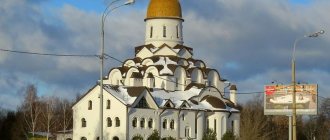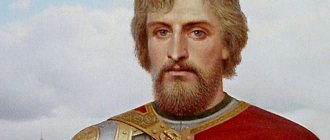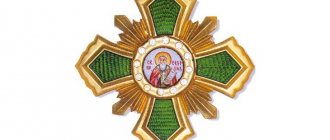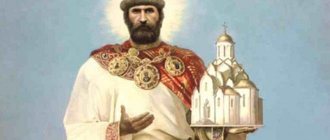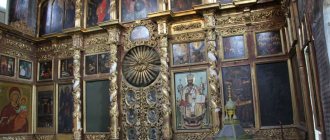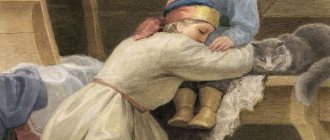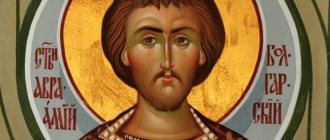| Blgv. book Roman Uglichsky |
Roman Uglichsky
(1235 - 1285), holy noble prince Memory of February 3, February 24 on the day of the discovery of the relics, May 23 in the Cathedral of Rostov-Yaroslavl Saints
The son of Uglich Prince Vladimir and Princess Photinia, nephew of the blessed Vasilko, Prince of Rostov, was born on October 1, 1235.
He was still a young man when Khan Batu with his hordes invaded Russia. Roman's father, Prince Vladimir, left Uglich and went to Novgorod, where he wandered with his family for about 8 years. Then he returned to Uglich and, having traveled to the Horde, received permission from the khan to manage his estate. After his death, his eldest son Andrei became the prince of Uglich, who, however, soon died, and in 1261 Roman took over the administration of the principality.
He set up almshouses and hospice houses and received in them the poor who came to him from everywhere. He erected more than 15 temples in the principality. Every day Saint Roman was present at divine services and often talked with pious monks. After the death of his wife in 1280, he devoted himself entirely to the feats of fasting, prayer and charity. He built the city of Romanov (now Tutaev) on the high bank of the Volga. The holy prince died peacefully on February 3, 1285 and was buried in the Church of the Transfiguration in Uglich.
In 1486, the relics of Saint Roman were found incorrupt and transferred to the new cathedral Church of the Transfiguration. In 1595, with the blessing of the Patriarch of Moscow, Saint Job, as a result of news of miracles, the relics were witnessed by the Kazan Metropolitan Saint Hermogen, and Prince Roman was canonized. In 1609, during the invasion of the Poles, the holy relics burned down along with the temple, but were not completely lost, and in 1611, along a luminous pillar above them, they were recovered from the ashes a second time. Subsequently, the remains of the relics of the blessed prince were kept in a special chapel dedicated to his name in the Uglich Cathedral. Since 1930, the relics were in the Uglich Museum, and in 1989 they were returned to the Church, after which they were placed in the Uglich Demetrius Church on the field [1].
Life
Saint Roman the Blessed Prince of Uglich was born in the 13th century. during an alarming time, when the Russian lands were constantly besieged by the Tatar tribes with their campaigns. The prince's father, Vladimir Konstantinovich, was forced to express formal submission to the Tatar Khan and pay tribute in order to save the lives of the Uglich people and his family. But, as the legend says, he did not take a direct oath to the khan and, avoiding responsibility for this, he almost did not live in Uglich. The childhood of the blessed Prince Roman, like his elder brother Andrei, was thus spent in the midst of terrible anxieties and disasters, more in exile and wanderings than in a calm stay with his parents in Uglich.
After the death of Vladimir, his eldest son Andrei, who was only 16 years old, became the prince of Uglich. But his mother was with him, who led the children. Andrei died in 1261, leaving no children, and the Uglich reign went to his brother Roman, who was then 26 years old.
Having grown up in the pious family of Prince Vladimir Konstantinovich among terrible anxieties and trials, having spent a lot of time wandering, Prince Roman was distinguished by his piety and did not have a great inclination towards a noisy life and fun. Being quite enlightened, he read books, loved the churches of God, the clergy and church services. During the difficult times of Tatar rule, peace reigned in the Uglich principality under the leadership of Prince Roman. He embodied his veneration for the Lord in the construction of 15 temples on the territory of his principality. Every day the prince could be seen at services, as well as talking with monks. Roman Uglichsky was distinguished by his charity, taking care of the establishment of almshouses and hospices.
In 1265, Prince Roman married Princess Alexandra, but had no offspring. Living with him in Uglich was his pious mother, Princess Photinia, who in her old age accepted the monastic rank with the name Evdokia, died in 1278 and was buried in Uglich next to her husband. In 1281, Prince Roman lost his wife Alexandra and decided to devote himself entirely to serving God and works of piety. On the banks of the Volga he built the city of Romanov.
Exactly two hundred years after the death of Prince Roman in the fortress of the city of Uglich, Uglich Prince Andrei Vasilyevich began building a new stone Cathedral of the Transfiguration of the Lord. While digging a ditch to found a new temple, the Lord granted Prince Andrey to find the incorruptible relics of Roman of Uglich, which were then placed in the newly built temple and lay there safe and sound for more than one hundred and twenty years. Numerous miraculous healings from various diseases flowed from these incorruptible relics. The fame of these miracles spread everywhere, and Patriarch Job instructed the Kazan Metropolitan Hermogenes to examine the holy relics and stories of miracles on the spot. After this examination, His Holiness Patriarch Job gave his blessing to compile the life, stichera and canon of Saint Roman, as well as a description of the miracles that began to occur from the relics from February 3, 1605.
Life of the Holy Prince
From childhood, Roman’s life was marked by a special attitude towards religion. He could sit for a long time reading the holy scriptures or praying. He was born in the 30s of the 13th century. His father and older brother died early, which prompted him to become a manager of Uglich at the age of 26. Many noted that he tried to help those in need; special houses were set up for this purpose.
He embodied his veneration for the Lord in the construction of 15 temples on the territory of his principality. Every day he could be seen at services, as well as talking with monks. In 1280, his wife died and he decided to devote himself entirely to serving God. On the banks of the Volga he built the city of Romanov.
The best article for you, go to: “The Sign” icon of the Mother of God, how it helps
He passed away peacefully into another world. The body was buried in the Transfiguration Church of his hometown. After being transferred to a new church, it was discovered that the relics remained incorrupt and he was canonized. But they have not survived to this day, since they burned down along with the temple during the Polish invasion.
Holy relics
In 1611, the city of Uglich suffered the great disaster of the Time of Troubles: the Polish devastation. The Uglich residents were demanded to recognize the authority of the Polish king Sigismund III over them. During the confrontation, Uglich was burned and destroyed to the ground, and with it the Transfiguration Cathedral. Subsequently, pious admirers of Saint Roman found and collected the burnt bones of his relics: head, ribs, arms and legs, placed them in a reliquary and placed it in the new cathedral Church of the Transfiguration, where they rest to this day.
Saint icon
The icon of the Holy Prince Roman of Uglich is a personal icon for a man with the name Roman.
Words have special power when they are pronounced with faith in front of the icon of St. Roman of Uglich. What should we pray to the blessed prince for? There is information that it is most effective to ask for help from Saint Roman in making important decisions, money matters, strengthening faith, getting rid of illnesses, preventing misunderstandings and disputes.
On the days of veneration of the saint, February 16 (February 3 - according to the old style) and June 5 (the day of the Council of Rostov-Yaroslavl Saints), it is customary to read an akathist to Roman of Uglich, prayers and a troparion.
Troparion to the Blessed Prince Roman of Uglich, tone 4
From infancy you appeared, / faithful to Prince Roman, / chosen by God, / a pillar of unconquerable piety, / you kept your faith immaculate, / through prayers and alms and fasting you pleased God ́;/ even after death the lordship of your life appeared,/ for you healed the ailments of the infirm ,/ by faith flowing to your holy tomb./ For this reason we cry out to you:/ Rejoice, saint of God Roman,// praise and affirmation for the city of Uglech.
How does prayer to a saint help?
All petitions will be heard only when they are endowed with faith in the Lord and pure thoughts. Remember that not everything depends only on the saint, for the most part our faith plays a role. So what do they pray to the holy prince for? There is evidence that it is most effective to ask him for help in:
- making important decisions;
- money issue;
- strengthening faith;
- preventing misunderstandings and disputes;
- getting rid of illnesses.
Words have special power when they are pronounced in front of the icon of Roman of Uglich. When reading prayer tests, try to focus as much as possible on the positive result and abstract from everything.
There are several different options for petitioning him. They all differ in what exactly needs to be achieved. Everyone chooses exactly the option that suits their given life situation.
On the day of veneration of the saint, February 3, it is customary to read an akathist to Roman of Uglich, prayers and a troparion.
Troparion of the Righteous Prince Roman of Uglich
From infancy you appeared, / true believer to Prince Roman, / chosen by God / an invincible pillar of piety, / you kept the immaculate faith, / you pleased God with prayers and alms and fasting; / in the same way, even after death, the lordship of your life appeared, / for healing the ailments of the infirm ,/ by faith flowing to your holy tomb./ For this reason we cry out to you:/ Rejoice, servant of God Roman,/ praise and affirmation of the city of Uglech.
Troparion of the Blessed Prince Roman of Uglich
From early childhood you appeared, God-Wise,/ to the all-blessed Prince Roman,/ the Divine vessel chosen by God,/ and now give us many healings,/ and drown all the ailments,/ and save your city Uglech,/ and save all the faithful from invisible and visible enemies,/ By faith, we pray, blessed Prince Roman, / pray to Christ God to save our souls.
Troparion of the Blessed Prince Roman of Uglich
Appearing like a bright star, / the faithful Prince Roman, / in the God-entrusted city of Uglech, / enlightened in his belly / with abstinence and all-night standing, / with fasting, and prayer, and tears, / praying to the All-Merciful Savior for his city / and for the entire country of the Russian land, / and after your repose you pour forth healing unsparingly / to those who come with faith, / with the same cry to you: / pray to Christ God / to save our souls.
Kontakion of the Righteous Prince Roman of Uglich
Like a many-bright star, / your all-celebration memory rises today, blessed Prince Roman, / calling your people to praise, / glorifying your honest life with songs, / and faithfully celebrating your holy dormition, / in which you pray, holy, to Christ our God, / get rid of all the slander of the enemy, / let us all call you: / rejoice, rich Roman, new Russian miracle worker.
Kontakion of the Righteous Prince Roman of Uglich
Having finished a good deed, / and kept faith in your hearts, / and you received an imperishable crown from God, / blessed Prince Roman, / and you were worthy of His glory, / and you appeared before the Throne of Spasov. / Praying to the Lord to save the city of Uglech and all the cities / from the invasion of foreigners, and internecine warfare, and the filthy, / and your honest repose to those who honor / grant forgiveness of sins / to those who honor your holy memory with love.
Saint Demetrius of Rostov - Lives of the Saints
| SEARCH | FORUM |
The Life of the Holy Blessed Prince Roman, the Wonderworker of Uglich1
Memory 3 February
With the Holy Blessed Prince Roman of Uglich lived during the difficult time of the Tatar invasion of Russian soil. He was the second son of the second Uglich appanage prince Vladimir Konstantinovich and the grandson of Konstantin Vsevolodovich, first the appanage prince of Rostov, Yaroslavl and Uglich, and then the Grand Duke of Vladimir. Vladimir Konstantinovich received the Uglich field, or the city of Uglich, as his inheritance in early childhood. Having married Princess Photinia, he had two sons - Andrei and Roman.
During the reign of Vladimir in Uglich, a terrible thunderstorm broke out over the Russian land, and together over Uglich: Batu, after the ruin of Moscow and Vladimir and the beating of the Grand Duke’s family here, moved across the Volga, where Grand Duke Yuri Vsevolodovich retired, gathering troops. On this path, the Tatars subjugated all the cities they came across, and those that did not want to submit ravaged and beat their inhabitants. In view of the obvious and inevitable danger, the Uglich prince Vladimir decided not to resist fruitlessly, but to save the city and residents by submitting to the Tatars. However, he himself and his family did not want to endure the shame and sought salvation in the north, retiring to the Novgorod borders. After the unfortunate battle on the City River and the death of Grand Duke Yuri, the Russian princes had to recognize the power of the Tatars and pay them tribute. The Uglich prince also had to submit to this fate, who, after Batu moved to the south, like other princes, after passing the danger, returned to Uglich and began to rule as the khan’s henchman. It is not known whether Prince Vladimir went to the horde to express submission to the khan, as was required and as all sovereign princes were supposed to do. The legend, recorded in a lengthy life, says that Vladimir did not join the horde, but, in order to avoid responsibility, he did not stay in Uglich, but lived in other cities and died in Vladimir in 1249 on December 27. His body was then transferred by his wife and children to Uglich and buried in the Transfiguration Cathedral.
The childhood of the blessed Prince Roman, like his elder brother Andrei, was thus spent in the midst of terrible anxieties and disasters, more in exile and wanderings than in a calm stay with his parents in Uglich.
After the death of Vladimir, his eldest son Andrei, who was only 16 years old, became the prince of Uglich. But his mother was with him, who led the children. Andrei died in 1261, leaving no children, and the Uglich reign went to his brother Roman, who was then 26 years old.
Having grown up in the pious family of Prince Vladimir Konstantinovich among terrible anxieties and trials, having spent a lot of time wandering, Prince Roman was distinguished by his piety and did not have a great inclination towards a noisy life and fun. Being quite enlightened, he read books, loved the churches of God, the clergy and church services. His reign includes the construction of many churches in Uglich and within the boundaries of the Uglich principality, which under him enjoyed peace as much as possible during the difficult times of Tatar rule. The power of Prince Roman, in addition to Uglich, extended to other cities: Kashin, Vezhetsky Verkh, Ustyuzhna, Dmitrov, Zvenigorod. He also owned the construction of the new city of Romanov on the left high bank of the Volga opposite the Borisoglebskaya settlement.
Prince Roman was distinguished by his charity, taking care of the establishment of almshouses and hospices.
In 1265, Prince Roman married Princess Alexandra, but had no offspring. Living with him in Uglich was his pious mother, Princess Photinia, who in her old age accepted the monastic rank with the name Evdokia, died in 1278 and was buried in Uglich next to her husband. In 1281, Prince Roman lost his wife Alexandra and lived out his last years alone, indulging in deeds and deeds of piety. His blessed death followed on February 3, 1285, to the great sadness of his subjects and related princes who loved and revered him. The body of Prince Roman was laid in the cathedral Church of the Transfiguration of the Lord, next to the tombs of his father, mother, brother and wife.
Exactly two hundred years after the death of Prince Roman, precisely in 1485, the Uglich prince Andrei Vasilyevich began building a new, already stone Cathedral of the Transfiguration of the Lord in the fortress of the city of Uglich. While digging a ditch for the foundation of a new temple, God granted Prince Andrey to find the incorruptible relics of Prince Roman, which were then placed in the newly built temple and lay here safe and sound for more than one hundred and twenty years. Numerous miraculous healings from various diseases flowed from these incorruptible relics. Both the residents of Uglich and the surrounding areas reverently honored the relics of the holy prince, but there was no evidence from the church authorities.
After the murder of Tsarevich Dmitry in Uglich at the end of the sixteenth and the first years of the seventeenth century, miraculous healings of the sick who flocked to the relics of Holy Prince Roman began to be repeated especially often. The fame of these miracles spread everywhere, and Patriarch Job instructed the Kazan Metropolitan Hermogenes to examine the holy relics and stories of miracles on the spot. After this examination, His Holiness Patriarch Job gave his blessing to compile the life, stichera and canon of Saint Roman, as well as a description of the miracles from February 3, 1605.
In 1609, the city of Uglich suffered a great disaster, like all of Rus' at that time: the Lithuanian ruin. The city of Uglich was taken, the inhabitants were killed in large numbers, and the houses, fortress and temples of God were plundered and burned. The enemies broke into the Transfiguration Cathedral, plundered and burned a lot, and deliberately the relics of Saint Prince Roman, which rested there. Pious admirers of Saint Roman collected the burnt bones of his relics: head, ribs, arms and legs, placed them in a new shrine and again placed them in the cathedral Church of the Transfiguration, where they rest to this day.
On this day the memory of St. Anna the prophetess is celebrated. Saint Anna the prophetess, remembered in the Gospel, together with Saint Simeon the God-Receiver, having met the Lord Jesus in the temple, preached about Him that He is the expected Messiah - Christ .
Notes:
In 1605, from February 3, miracles began to be performed from the relics of Holy Prince Roman of Uglich. Patriarch Job then instructed Kazan Metropolitan Hermogenes, later patriarch, to examine the relics of the holy prince in Uglich and verify information about miracles. With the blessing of Patriarch Job, the governor Semyon Romanovich Olferyev and the monk of the Pereyaslav Danilov Monastery Sergius compiled the life, service and description of miracles (from February 3, 1605) of St. Prince Roman. After the Lithuanian devastation of the city of Uglich in 1609, this newly written life, as well as the tales of miracles from February 3 to March 2, 1605, could not be found; Only the service and the story of miracles from March 2 were rewritten. According to the manuscript kept in the Uglich Transfiguration Cathedral, the legend of the miracles of Saint Prince Roman was published in Yarosl. Eparch. Veda, for 1873 No. 46-48 and a separate brochure: “The Tale of the Miracles of the Holy Blessed Prince Roman, the Uglich Wonderworker.” Yaroslavl. 1874. We know the service and the story of miracles from several other manuscripts. After the loss of the life written in 1605, subsequently, in the 18th century, at the Uglich Transfiguration Cathedral, a new lengthy life was compiled “from the most ancient chroniclers and reliable geographical history writers”; according to the list of the 18th century. This life was published in Yarosl. Eparch. Ved. for 1889 No. 48-49 and a separate brochure: “The Life of the Holy and Faithful Prince Roman Vladimirovich, Uglich Wonderworker.” Yaroslavl. 1890. The data of the “Tale” and “Life” mentioned here in this presentation have been verified by references to chronicles and other evidence.
Konstantin was the son of Grand Duke Vsevolod III Yuryevich Big Nest, b. in 1185; from 1207 he was the appanage prince of Rostov, Yaroslavl and Uglich, and from 1216 the grand prince of Vladimir; died in 1219.
He is born. around 1214
Prince Vladimir married in 1232; Prince Andrei was born in 1233, and Roman was born on October 1, 1235.
Andrei Vasilyevich, son of Grand Duke Vasily Vasilyevich the Dark and brother of Grand Duke John Vasilyevich III, reigned in Uglich from 1462; in 1422 he was imprisoned by John III in Pereyaslavl, where he died in 1494.
The life of Saint Roman and the description of his first miracles perished during the Lithuanian devastation. The description of miracles from his relics was preserved along with the service to Saint Roman only from March 2 of the same 1605.
Luke 2:36-38. — More about St. To Anna the prophetess, see p. 383.
Prince Roman Vladimirovich
The thirteenth century is one of the most intense periods of Russian history.
At the beginning of the 13th century. Russian lands were experiencing a period of feudal fragmentation. A feature of their development at this time was a change in the social structure, the migration of the Slavic population from the south to the northeast, the strengthening of new cities, the emergence of new political centers, and the flourishing of culture. In the first third of the 13th century, the volost of the Rostov-Suzdal principality, defined by the term “Ugleche Pole” (Tomsinsky), “sovereignized” into the Uglich principality. The first Uglich prince Vladimir Konstantinovich married in 1232, and the Ryazan princess Evdokia Ingvarevna became his wife. In this union, two sons were born: the elder Andrei and the younger Roman Vladimirovich, who later inherited the Uglich throne.
S.V. Tomsky in his monograph “Ugleche Pole in the 9th – 13th centuries” pays special attention to the names of his sons. If the name Andrei has been found among the Suzdal Monomakhovichs since the middle of the 12th century, then the name Roman for this princely house should be considered rare. The only bearer of such a name in the 12th – 13th centuries turns out to be Roman Vladimirovich of Uglich. In the Ryazan dynasty, the name Roman was not uncommon (Example “Great and appanage princes of Northern Rus' in the Tatar period, from 1238 to 1505: Volume I - II.). Most likely, one of the sons of Vladimir Konstantinovich was named “on the paternal side”, and the second - “on the maternal side”, as was often the case in the families of the ancient Russian nobility.
In the second third of the 13th century. Blooming but fragmented Rus' suffered a terrible disaster - the invasion of the Mongol-Tatars. Ryazan, Kolomna, Suzdal, Vladimir, Moscow and other cities of North-Eastern Rus' in the winter of 1237 - 1238 were subjected to severe defeat.
F.H. Kissel in his work “History of the City of Uglich” says that Uglich was not ruined, thanks to the fact that Vladimir Konstantinovich, after consulting with the boyars and clergy, with all his “family and best treasures, retired from Uglich to Novgorod, and took refuge there until a stormy hurricane swept across the Asian steppes.”
According to other information (Copy “Great and appanage princes of Northern Rus' in the Tatar period, from 1238 to 1505: Volume II p. 126.) Vladimir Konstantinovich, together with his brothers, sided with Grand Duke Yuri and participated in the battle on the river. City on March 4, 1238, and was among the princes whom “God saved from the Tatar sword.”
In the absence of the prince, the Uglich residents voluntarily surrendered the city to the mercy of Batu.
Thus, Roman was only 2 years old when Batu moved to Rus'. The princely family spent three whole years on Novgorod land. After the danger had passed, the Uglich prince and his family returned to Uglich. In 1248, “Tatar officials appeared in Uglich, Prince Vladimir went to Vladimir and died in 1249. The eldest son Andrei took the Uglich throne” (Lives of Russian Saints, p. 237).
The all-Russian chronicle (Lavrentievskaya, etc.) is silent about the activities of the sons of Vladimir Konstantinovich, reporting only about their death in 1261 and 1285. Both princes died childless, and the dynasty of the Uglich Konstantinovichs came to an end in 1285 after the death of Roman Vladimirovich.
Information about the reign of Andrei and Roman can be found in the Uglich chronicler, who is referred to, and F.Kh. Kissel, and L.F. Solovyov in his works devoted to the history of Uglich. From recent publications: “The Lives of Russian Saints” and the book “The Holy Blessed Roman of Uglich”, compiled by Archimandrite Veniamin, Tutaev 2009. One way or another, all of the listed literature refers to the Uglich chronicler, compiled no earlier than the 18th century, as the basis, which most likely included earlier sources that have not survived to this day.
According to the chronicler and the sources presented above, Roman was born in 1235. His childhood, like that of his elder brother Andrei, was spent amid terrible anxieties and disasters, mostly in exile and wanderings. The authors very often give a detailed, personal description of the prince, as if they knew him personally. A description of the character and personal qualities of the prince is found in Kissel, and he, in turn, is, without a doubt, inspired by the Uglich chronicler: “... this faithful and Christ-loving second son of Vladimirov Roman, Prince of Uglich and a godly ruler, who surpassed him in virtue and charity rulers incomparably, and with an immaculate life please God in the end, and achieve the most righteous heavenly settlement..." such epithets are used to describe the Roman of Uglich in the chronicle. One gets the impression that the author of the chronicle personally knew the prince or was his contemporary. Hence, in life we find a similar description of character. Roman Vladimirovich took the Uglich throne in 1261 after the death of his older brother Andrei Vladimirovich. At that time he was 26 years old. As life says, having grown up in the pious family of Prince Vladimir Konstantinovich amid terrible anxieties and trials, having spent a lot of time wandering, Prince Roman was distinguished by piety and did not have a great inclination towards a noisy life and fun. Being quite enlightened, he read books, loved the churches of God, the clergy and church services. (Life, pp. 4-5). His character became the starting point, the foundation connecting his subsequent actions as a ruler, described in the “History of the City of Uglich.” Prince Roman did not leave his city and principality to fight or feast with other princes, and did not sit as a schema-monk in his princely palace, but together with his subjects decided matters in the Duma. He judged his principality with meekness, ruled with wisdom - he built hospitals and hospice houses in Uglich and in monasteries. The former were supported by the princely treasury, and the latter by the monastery. He expanded and rebuilt his (princely) palace. He built more than 15 churches in Uglich and other cities and villages, and also decorated them with rich contributions. But the most significant act of Prince Roman Vladimirovich was the founding of a new city, which was named Romanov in honor of its founder. The Uglich chronicler talks about the construction of Romanov (page 63.) Kissel points out 2 reasons for the founding of the city: 1. A new place of trade 2. A place to protect the northern regions of the Uglich principality, or both reasons at once. In 1238, Yaroslavl was subjected to a Mongol attack. Some of the Yaroslavl residents, escaping from the invasion, settled in the Boris and Glebs settlement. And already Prince Roman Vladimirovich, having arrived in the future Borisoglebsk, saw on the other bank a place ideal for creating a fortified settlement; the first builders of Romanov were Borisoglebsk residents and settled residents from Yaroslavl. Later, the Borisoglebsk settlement became a settlement, and in 1777 it was transformed into the city of Borisoglebsk. In 1822, Romanov and Borisoglebsk were united into a city, now Tutaev since 1918. The power of Prince Roman extended to other cities. Under him, the Uglich principality was called the Seven-City Principality. As it is said in the chronicler: “... at that time the Uglisk reign was called seven-degree, or ten-degree, and the Uglisk prince was seven-degree, or ten-degree sovereign and great ruler.” Cities and settlements that were under the rule of Prince Roman: Kashin, Bezhetsky Verkh, Zhelezny Ustyug, Dmitrov, Zvenigorod, Romanov and Uglich, as the capital and concentration of power. Also subordinate settlements: Borisoglebskaya, Rybnaya, Mologskaya.
It is also known that Roman Vladimirovich was married. The wife's name was Alexandra, but nothing is known about her except her name. It is possible, and most likely, that she was a princess. There were no children from this union. Roman Vladimirovich died in 1285 without leaving an heir. The Uglich throne passed to the Rostov prince Dmitry Borisovich, grandson of Vasilko Konstantinovich (brother of Vladimir Konstantinovich). The body of Prince Roman was laid in the cathedral Church of the Transfiguration of the Lord, next to the tombs of his father, mother, brother and wife.
At L.F. Solovyov has a similar account of the history of the reign of Roman Vladimirovich. Thus, Prince Roman of Uglich is presented as beneficent, wise, meek, pious - qualities inherent in a holy man, which Roman of Uglich is, was canonized in the XVI century - beginning. XVII century. The Uglich chronicler dates back to the beginning of the 18th century, so it is not surprising that Roman Vladimirovich was already presented as a saint in it.
S.V. Tomsinsky in his monograph “Ugleche Pole in the 9th – 13th centuries” suggests the presence of an earlier work, which he conventionally calls “The Tale of the First Princes of Uglich”. According to Tomsinsky, there may have been two editions. The first edition could have arisen during the period when the memory of the events of 1238 - 1285 was still preserved in the oral tradition, shortly after the death of Roman Vladimirovich. After the division of the possessions of the Rostov princes, who dragged Uglich into strife and the devastating defeat of 1293 during the campaign of the Horde commander Tudan (Dyuden), nostalgic memories of the first princes could not help but intensify, under whom the Uglich residents did not know such misfortunes and were saved even during Batu’s invasion .
The second edition of “The Tale of the First Princes of Uglich” should presumably be attributed to the period following the great fire of 1491, which destroyed most of the city, and the subsequent destruction of the Uglich appanage by Ivan III.
According to S.V. Tomsinsky, back in the 1480s, the Uglich prince Andrei Vasilyevich Bolshoi established the cult of Roman Vladimirovich of Uglich, as a peace-loving, justice-loving ruler who cared about the church and people, the patron of a new appanage dynasty. Thus, Andrei Bolshoi, who actively opposed the Grand Duke of Moscow until 1491, seemed to be the legitimate successor of the first Uglich princes.
In other words, if the version about earlier editions of the work about the first Uglich princes is correct, then we can talk about the superposition of the events of the 15th century on the events of the 13th century, which was also facilitated by the stable sympathy for the appanage princes of the local Uglich scribes of the early 18th century.
Unfortunately, all-Russian chronicles did not preserve information about the period of Roman Vladimirovich’s reign. From them we only know that such a prince existed, but he was not noted for any special deeds in the chronicle. On the one hand, this may indicate that things were really calm in Uglich in those years, but on the other hand, there is a complete gap. Only the Uglich chronicler gives a more detailed version of the narrative about the period of local history of the second half of the 13th century, but we should not forget that as a source it is much later, therefore, there is a high probability of including fragments based on local traditions and legends created against the backdrop of nostalgia for the past at times.
One thing is clear that during the reign of the Konstantinovich dynasty (Vladimir, Andrei, Roman), Uglich managed to avoid the terrible fate of other cities. This could be a consequence of the wise policy of the Uglich princes. Perhaps Andrei and Roman Vladimirovich really directed all their efforts towards the development and preservation of their appanage principality, and the Uglich chronicler managed to convey, if not an accurate chronicle of the events of the second half of the 13th century, then at least characterize this difficult era.
Ermilov Anton Igorevich
x
subscribe to news
X
Subscribe to museum news
Icon "St. Roman of Uglich" to order
The Life of the Holy Blessed Prince Roman, the Wonderworker of Uglich
Memorial Day: June 5, February 16
The holy noble prince Roman of Uglich lived during the difficult time of the Tatar invasion of Russian soil. He was the second son of the second Uglich appanage prince Vladimir Konstantinovich and the grandson of Konstantin Vsevolodovich. Vladimir Konstantinovich received the Uglich field, or the city of Uglich, as his inheritance in early childhood. Having married Princess Photinia, he had two sons - Andrei and Roman.
The childhood of the blessed Prince Roman, like his elder brother Andrei, was thus spent in the midst of terrible anxieties and disasters, more in exile and wanderings than in a calm stay with his parents in Uglich.
In 1261, the Uglich reign went to Roman, who was then 26 years old.
Prince Roman was distinguished by his piety and did not have a great inclination towards a noisy life and fun. Being quite enlightened, he read books, loved the churches of God, the clergy and church services. His reign includes the construction of many churches in Uglich and within the boundaries of the Uglich principality, which under him enjoyed peace as much as possible during the difficult times of Tatar rule.
In 1265, Prince Roman married Princess Alexandra, but had no offspring. Living with him in Uglich was his pious mother, Princess Photinia, who in her old age accepted the monastic rank with the name Evdokia, died in 1278 and was buried in Uglich next to her husband. In 1281, Prince Roman lost his wife Alexandra and lived out his last years alone, indulging in deeds and deeds of piety. His blessed death followed on February 3, 1285, to the great sadness of his subjects and related princes who loved and revered him. The body of Prince Roman was laid in the cathedral Church of the Transfiguration of the Lord, next to the tombs of his father, mother, brother and wife.
Do you want to buy an icon of St. Roman of Uglich? The icon painting workshop “Creating a Heritage” is happy to help you in this good cause. On our website you can choose an icon of St. Roman of Uglich from stock or order its painting. Our artists work in different icon painting techniques and with equal skill create both modest pictorial icons and ceremonial images on gold. If desired, the icon of St. Roman of Uglich can be decorated with a handmade frame and placed in an icon case. All icons are consecrated in the Temple!
Calendar, when according to the church calendar is Roman’s name day:
- January 18: Roman, prmch.; Roman, sschmch.
- February 11: Roman Samosatsky, martyr.
- February 16: Roman Uglichsky, prince
- March 2: Roman, St.
- March 29: Roman Pariysky, martyr.
- May 15: Boris (baptized Roman), passion-bearer, prince
- June 13: Roman of Nicomedia, martyr.
- August 1: Roman Olegovich, Ryazan, martyr, prince
- August 6: Boris (baptized Roman), passion-bearer, prince
- August 11: Roman Kirzhachsky, St.
- August 15: Roman
- August 23: Roman Rimsky, martyr.
- September 24: Roman, martyr.
- October 8: Roman, martyr.
- October 14: Roman Sweet Singer, Constantinople, deacon. [creator of canons]
- November 13: Roman
- December 1: Roman of Caesarea, Antioch, schmch., deacon
- December 10: Roman of Antioch (Syrian), hermit. [miracle worker]
